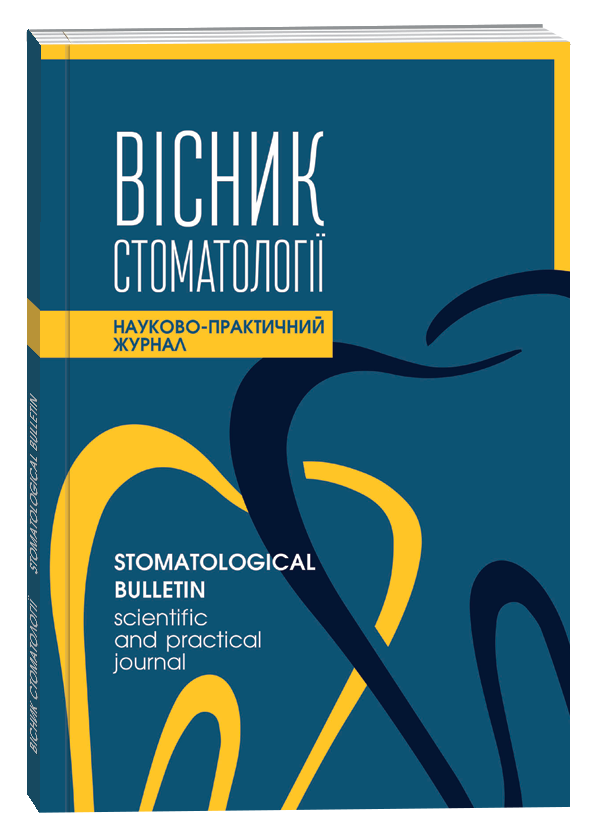EXPERIMENTAL JUSTIFICATION OF THE APPLICATION OF COMBINED BIOMATERIALS FOR BONE REGENERATION
DOI:
https://doi.org/10.35220/2078-8916-2022-45-3.13Keywords:
augmentation, membrane, experimental model, morphology, bone material, actovegin.Abstract
As a result of irrational prosthetics and mistakes made during endodontic and periodontal treatment, as well as in the presence of a chronic inflammatory process accompanied by local and systemic bone loss, cases of destructive changes in the jaws are very common among the population and often lie beyond the reparative capabilities of the body. The aim of the study is to experimentally evaluate the effectiveness of the use of various combinations of osteoplastic material and actovegin in the processes of regeneration and neoplasm of bone tissue. Experimental studies were conducted in vivo on 36 male rabbits weighing from 1.5 to 2.5 kg on the basis of the Scientific Research Center of the Azerbaijan Medical University. In group I, divided into two subgroups, the bone defect was filled with a mixture of allograft and platelet-rich fibrin PRF (subgroup A), and in subgroup B, actovegin was added to this combination for this purpose; Group II – comparison group, a mixture of autologous bone, platelet-rich fibrin, and actovegin was applied to the defect formed in the lower jaw; in the control group III, platelet-rich fibrin was injected and at the same time the animals were injected intravenously with actovegin at a dose of 1 mg daily for 2 weeks. Based on the data obtained, it can be concluded that autogenous bone is more effective than allograft and, together with PRF, contributes to faster replacement of the artificial defect with new bone tissue and also its rapid healing. Although the local application of actovegin does not directly affect the process of bone tissue formation, the drug improves blood circulation in the residual zone, eliminates hypoxia and thus creates favorable conditions for enhancing osteogenesis.
References
Faraedon M. Zardawia, Alaa N. Aboudb, Dler A. Khursheeda A retrospective panoramic study for alveolar bone loss among young adults in Sulaimani City. Iraq ulaimani Dent. J. 2014; 1:94-98 DOI:10.17656/ sdj.10028.
Li Y, Ling J and Jiang Q Inflammasomes in Alveolar Bone Loss. Front. Immunol. 2021. 12:691013. doi: 10.3389/fimmu.2021.691013
Greene A.C., Shehabeldin M., Gao, J. et al. Local induction of regulatory T cells prevents inflammatory bone loss in ligature-induced experimental periodontitis in mice. Sci Rep. 2022;12: 5032. https://doi.org/10.1038/ s41598-022-09150-8
Huang, X., Xie, M., Xie, Y. et al. The roles of osteocytes in alveolar bone destruction in periodontitis. J Transl Med. 2020;18: 479. https://doi.org/10.1186/ s12967-020-02664-7.
Sun K., Shen H., Liu Y., Deng H., Chen H., Song Z. Assessment of Alveolar Bone and Periodontal Status in Peritoneal Dialysis Patients. Front. Physiol. 2021;12:759056. doi: 10.3389/fphys.2021.759056.
Lykoshin D.D., Zaytsev V.V., Kostromina M.A., Yesipov R.S. Osteoplasticheskiye materialy novogo pokoleniya na osnove biologicheskikh i sinteticheskikh matriksov. Tonkiye khimicheskiye tekhnologii. 2021;16(1):36–54. https://doi. org/10.32362/2410-6593-2021-16-1-36-54 (In Russian).
Arab H., Shiezadeh F., Moeintaghavi A., Anbiaei N., Mohamadi S. Comparison of Two Regenerative Surgical Treatments for Peri-Implantitis Defect using Natix Alone or in Combination with Bio-Oss and Collagen Membrane. J Long Term Eff Med Implants. 2016;26(3):199-204. doi: 10.1615/JLongTermEffMedImplants.201601639 6.
Carvalho M., Kassis E. Bone regeneration processes with the use of biomaterials and molecular and cellular constituents for dental implants Journal of Medical and Health 2022; (3) 1: 23-25.
Li P., Zhu H., Huang D. Autogenous DDM versus Bio-Oss granules in GBR for immediate implantation in periodontal postextraction sites: A prospective clinical study. Clin Implant Dent Relat Res. 2018 Dec;20(6):923-928. doi: 10.1111/cid.12667
Egido-Moreno S., Valls-Roca-Umbert J., Céspedes-Sánchez J.M., López-López J., VelascoOrtega E. Clinical Efficacy of Mesenchymal Stem Cells in Bone Regeneration in Oral Implantology. Systematic Review and Meta-Analysis. Int J Environ Res Public Health. 2021 Jan 21;18(3):894. doi: 10.3390/ijerph18030894.
Galli M., Yao Y., Giannobile W.V., Wang H.L. Current and future trends in periodontal tissue engineering and bone regeneration. Plast Aesthet Res 2021;8:3. http://dx.doi.org/10.20517/2347-9264.2020.176
Hatt L.P., Thompson K., Helms J.A., Stoddart M.J., Armiento A.R. Clinically relevant preclinical animal models for testing novel cranio-maxillofacial bone 3D-printed biomaterials. Clin Transl Med. 2022 Feb;12(2):e690. doi: 10.1002/ctm2.690.









